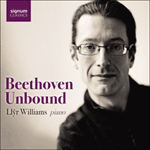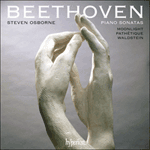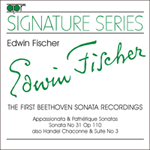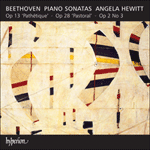
Welcome to Hyperion Records, a British classical label devoted to presenting high-quality recordings of music of all styles and from all periods from the twelfth century to the twenty-first.
Hyperion offers both CDs, and downloads in a number of formats. The site is also available in several languages.
Please use the dropdown buttons to set your preferred options, or use the checkbox to accept the defaults.



The notion of bringing back the Grave’s material at its original slow tempo at crucial points during the course of the Allegro was something new to Beethoven’s style, and it heralds the similarly integrated use of a slow introduction in the ‘Les Adieux’ Sonata Op 81a, and in some of the late string quartets. But the ‘Pathétique’ unifies its contrasting strands to an unusual degree, and the start of the movement’s central development section presents the introduction’s initial phrase transformed into the rhythm and tempo of the Allegro.
The Allegro begins with a staccato theme that spirals upwards, above the sound of a drum roll deep in the bass. In order to maintain the tension during his contrasting second theme, Beethoven has it given out not in the major, as would have been the norm, but in the minor; and the eventual turn to the major coincides with the arrival of a restless ‘rocking’ figuration, which far from alleviating the music’s turbulent atmosphere, serves only to heighten it. With the development section, and its abbreviated reprise of the slow introduction, Beethoven returns to the minor and does not depart from it again. The music’s continual agitation is halted only by the final appearance of the introduction, now shorn of its assertive initial chord, and sounding like an exhausted echo of its former self.
The slow movement forms a serene interlude in the key of A flat major. The sonority of its opening bars, with their broad melody unfolding over a gently rocking inner voice, is one that was much admired by later composers, and the slow movement of Schubert’s late C minor Sonata D958, whose reprise has a similar keyboard texture, provides one instance of a piece that was surely modelled on Beethoven’s example. Schubert also follows Beethoven in absorbing the rhythm of the middle section’s inner voice into the accompaniment when the main theme returns.
The slow movement’s key exerts an influence on the rondo finale, whose extended central episode, almost like a miniature set of variations in itself, is in A flat. Sketches for the finale appear among Beethoven’s ideas for his string trios Op 9, and since those preliminary drafts are clearly conceived with the violin in mind, it is possible that the sonata’s rondo theme was originally destined for the last of the trios, also in C minor. As so often with Beethoven, these initial thoughts show him trying to hit on a suitably dramatic way of bringing the piece to a close. That close is effected both in the sketches and in the sonata itself by means of a gentle fragment of the rondo theme, followed by a peremptory final cadence.
from notes by Misha Donat © 2010
La notion consistant à ramener le matériel du Grave à son tempo lent d’origine en plusieurs points cruciaux de l’Allegro était nouvelle dans le style de Beethoven et annonce l’utilisation intégrée de façon similaire d’une introduction lente dans la Sonate «Les Adieux», op. 81a, et dans certains des derniers quatuors à cordes. Mais la «Pathétique» unifie les éléments contrastés de sa trame à un point inhabituel et le début du développement central du mouvement présente la phrase initiale de l’introduction transformée dans le rythme et le tempo de l’Allegro.
L’Allegro commence par un thème staccato qui monte en spirale, sur une sonorité de roulement de timbales dans les profondeurs de la basse. Afin de maintenir la tension au cours de son second thème contrasté, Beethoven le donne non dans le mode majeur, comme l’aurait voulu la norme, mais dans le mode mineur; et l’arrivée différée du majeur coïncide avec celle d’une figuration agitée «balançante», qui loin de soulager l’atmosphère turbulente de la musique, ne sert qu’à la renforcer. Avec le développement et sa reprise abrégée de l’introduction lente, Beethoven revient au mode mineur pour ne plus s’en départir. L’agitation continue de la musique n’est interrompue que par l’apparition finale de l’introduction, maintenant dépouillée de son accord initial assuré, et qui ressemble à un écho épuisé de ce qu’elle a été.
Le mouvement lent constitue un intermède serein dans la tonalité de la bémol majeur. La sonorité de ses premières mesures, avec leur large mélodie déployée au-dessus d’une voix intérieure qui se balance doucement, a suscité l’admiration de compositeurs ultérieurs; le mouvement lent de la tardive Sonate en ut mineur, D958, de Schubert, dont la reprise présente une texture de clavier identique, est un morceau qui a sûrement été modelé sur l’exemple de Beethoven. Schubert a également suivi Beethoven en intégrant le rythme de la voix intérieure de la section centrale à l’accompagnement lorsque revient le thème principal.
La tonalité du mouvement lent exerce une influence sur le rondo final, dont le long épisode central, presque comparable à des variations miniatures, est écrit en la bémol majeur. On trouve des esquisses du finale dans les idées que Beethoven nourrissait pour ses trios à cordes, op. 9, et comme ces esquisses préliminaires sont clairement conçues en pensant au violon, il est possible que le thème du rondo de la sonate ait été destiné à l’origine au dernier de ces trios, également en ut mineur. Comme c’est si souvent le cas chez Beethoven, ces idées initiales le montrent en train d’essayer de trouver une manière dramatique appropriée pour mener le morceau à sa conclusion. Dans les esquisses comme dans la sonate elle-même, il parvient à cette conclusion au moyen d’un léger fragment du thème du rondo, suivi d’une cadence finale péremptoire.
extrait des notes rédigées par Misha Donat © 2010
Français: Marie-Stella Pâris
Das Allegro beginnt über einem Trommelwirbel im tiefen Bass mit einem spiralförmig aufsteigenden Staccato-Thema. Beethoven erhält die Spannung im zweiten kontrastierenden Themas aufrecht, indem er es nicht wie üblich in Dur, sondern in Moll setzt; und die schließliche Wendung nach Dur trifft zusammen mit dem Einsetzen einer rastlos „schaukelnden“ Figur, welche die turbulente Stimmung ganz und gar nicht besänftigt, sondern noch verstärkt. Im Entwicklungsteil mit der verkürzten Reprise der langsamen Einleitung kehrt Beethoven nach Moll zurück, um es dann nicht mehr zu verlassen. Die fortgesetzte Erregung kommt erst zum Stillstand mit der abschließenden Rückkehr der Einleitung ohne ihren selbstbewussten Anfangsakkord und wie ein erschöpftes Echo ihres früheren Selbst.
Der langsame Satz ist ein gelassen-heiteres Zwischenspiel in As-Dur. Die Klangfülle der einleitenden Takte mit ihrer über einer sanft wiegenden inneren Stimme sich breit entfaltenden Melodie wurde von späteren Komponisten sehr bewundert. Der langsame Satz von Schuberts später Sonate in c-Moll D958, deren Reprise eine ähnliche Tonstruktur hat, ist ein gutes Beispiel für ein Stück, das zweifellos an Beethoven orientiert ist. Auch folgt Schubert hier dem Vorbild von Beethoven, indem er den Rhythmus der inneren Stimme des Mittelteils in der Begleitung absorbiert, wenn das Hauptthema zurückkehrt.
Die Tonart des langsamen Satzes strahlt ihren Einfluss auf das Rondo-Finale aus, dessen erweiterter Mittelteil, in sich selbst fast ein Miniatursatz von Variationen, in As-Dur steht. Skizzen für das Finale finden sich unter Beethovens Ideen für seine Streichtrios op. 9, und da diese vorläufigen Entwürfe für die Geige konzipiert sind, war das Rondothema der Sonate möglicherweise ursprünglich für das letzte, ebenfalls in c-Moll stehende Trio bestimmt. Wie so oft versucht Beethoven hier, diese anfänglichen Ideen für einen geeigneten dramatischen Abschluss zu nutzen. Dieser Abschluss ist sowohl in den Skizzen wie auch in der Sonate selbst mittels eines zarten Fragments des Rondothemas ausgeführt, gefolgt von einer autoritativen Schlusskadenz.
aus dem Begleittext von Misha Donat © 2010
Deutsch: Henning Weber
 Beethoven: Beethoven Unbound Beethoven: Beethoven UnboundA comprehensive new cycle of the Beethoven sonatas recorded live at London's Wigmore Hall during the pianist's epic fourth rendition of these masterpieces .» More |
 Beethoven: Piano Sonatas Opp 13, 27/2, 53 & 79 Beethoven: Piano Sonatas Opp 13, 27/2, 53 & 79Steven Osborne has been performing Beethoven live in concert for many years, always to great acclaim. Now for the first time he has committed these extraordinary performances to disc. It is clear from listening to the opening movement of the ‘Moon ...» More |
 Edwin Fischer - The First Beethoven Sonata Recordings Edwin Fischer - The First Beethoven Sonata Recordings |
 Beethoven: Piano Sonatas Opp 2/3, 13 & 28 Beethoven: Piano Sonatas Opp 2/3, 13 & 28 |

